The Maryland Growth Machine must be a little worried
 Slow-growth policies and expansive use of land in Baltimore suburban counties are holding down the supply of new homes. (Sun photo by David Hobby). Click through to the article for a very large version of this image.
Slow-growth policies and expansive use of land in Baltimore suburban counties are holding down the supply of new homes. (Sun photo by David Hobby). Click through to the article for a very large version of this image.On Sunday, the Baltimore Sun started a three-part series on housing. The first piece is entitled "The coming housing crunch: Homebuilding limits, impending job surge are putting the region on a collision course."
I haven't figured out yet if the series will cover the 50,000 vacant properties in Baltimore (and I don't know how many vacant lots).
 This is a tremendous opportunity.
This is a tremendous opportunity.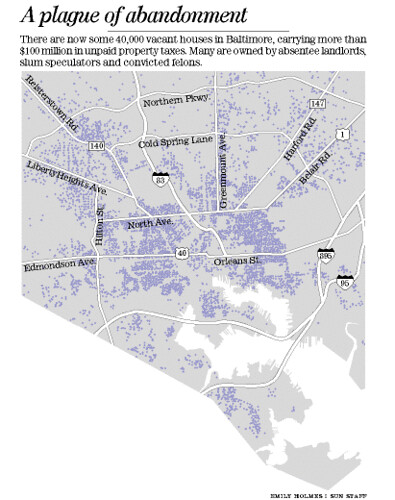 Baltimore Sun graphic.
Baltimore Sun graphic.One thing that always amazes me is that within a couple blocks of Baltimore's Penn Station, there are amazing numbers of vacant properties... And while Baltimore has plenty of types of rowhouses that are small, the city has so many rowhouses that are quite large.
Urban growth boundaries would help re-center development back towards the core. Location-efficient mortgages would help families pay for mortgages. But of course, being able to use transit and not a car is essential. Thus far, the Baltimore Sun series is focusing on deconcentrated development in the suburbs. But abandonment and disinvestment in the city should be an equal focus.
Steve Eldridge, in the Friday Baltimore Examiner ("Hopped-up hybrids being developed"), reported on the recent Citizens Planning and Housing Association study on bus arrival. It found that only 41% of buses arrived on time. Steve writes that because the buses are relatively infrequent--long headways--that this would be less of a problem if there were greater service and frequency. He's right. Baltimore's transit sucks. There's no other word to describe it.
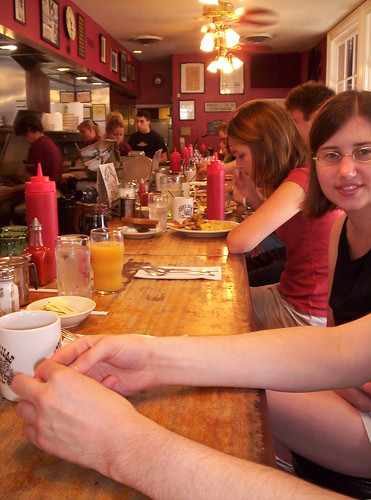 Pete's Diner. Greenmount Avenue in Waverly. In the Main Street "world," the Waverly district is considered comparable to H Street. To some extent I disagree. H Street has no restaurant like Pete's Diner. They aren't lying when they say they have the best home fries around.
Pete's Diner. Greenmount Avenue in Waverly. In the Main Street "world," the Waverly district is considered comparable to H Street. To some extent I disagree. H Street has no restaurant like Pete's Diner. They aren't lying when they say they have the best home fries around.From the Baltimore City Paper:
Pete's Grille (3130 Greenmount Ave., [410] 467-7698) is a blue-ribbon diner blessed with both neighborhood charm and terrific food (at, may we add, terrific prices). Breakfast at Pete's means heavenly hash browns, fluffy pancakes, and waffles made from scratch. It means perfect bacon and a coffee cup perpetually filled to the rim. As a matter of fact, we like to say that breaking fast at Pete's is a metaphor for living a successful life: simple, perhaps even old-fashioned pleasures, simply enjoyed. You won't find fancy foods with unpronounceable foreign names at Pete's, but you will find good cheer, community, and one of the best breakfasts anywhere.
And light rail, in the words of Danielle, Paul Johnson's girlfriend (they were kind enough to join me for breakfast at Pete's Diner in Waverly on Saturday, and then they took me around on a "windshield" survey of a number of Baltimore neighborhoods and areas) -- "Light rail doesn't go anywhere you want to go." Plus many of the stations are situated far far away from neighborhoods and dense housing. Better transit would reconnect neighborhoods.
Speaking of Waverly, their Saturday farmers market is one of the best in the region. Jammed with 30-40 vendors (I didn't count) including some prepared "artisan-quality" foods--3 bakeries, a couple florists, a coffee roaster, a place to set, just tons of stuff to see and do.
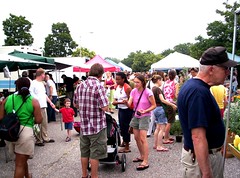
 And the prices are great too.
And the prices are great too.For example the "North Avenue" station is near neighborhoods, but not part of any. It would be like having to walk into the middle of DC's Southeast-Southwest Freeway to catch the subway...
 Urban homesteading a block in Reservoir Hill.
Urban homesteading a block in Reservoir Hill.In 2002, I was in Baltimore one weekend when this article ran in the Baltimore City Paper, "Moving Company," about how a way to focus individual efforts to revitalize neighborhoods. I've written about this many times, but never went to the area. Paul and Danielle showed me the street. From the article:
Specifically, their concept is called Buy a Block. The idea is to unite 12 to 20 ambitious, ready-to-roll-up-their-sleeves home buyers who want to acquire and renovate vacant city houses. If they can purchase their properties within a block or two of one another, they can achieve homesteading critical mass, developing an instant moral-support group, neighborhood watch, and social circle.
"We don't want to live in $1,000 [a month] apartments and we can't afford the 'hot neighborhoods,'" Meister says. "We're an eclectic group of native Baltimoreans and people that just love city life for what it is. We want our investment to be a contribution to the city."
Meister promotes the idea on www. techbalt.com, a Web site he initially started to unite other tech-savvy people in town. But the Reisterstown native, who moved back to Baltimore in 2001 after working at jobs in New York, Detroit, and Silicon Valley, shifted the site's focus to the Buy a Block concept after driving down a largely vacant stretch of Reservoir Hill's Callow Avenue. Meister says the area was "devastated" and "an open-air drug market." However, the street's large houses reminded him of Charles Village.
"I thought it would be cool if I could buy one of these houses and fix it up," he says. "I could probably [get one] for really cheap. But I would die. I would be eaten alive. But then I thought, What if it wasn't just me? What if I was one of 15 others?"
As the banner photo above says (a couple blocks away), up the street from this,
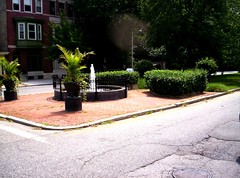 and down the street from that,
and down the street from that, There are opportunities.
There are opportunities.The tragic thing is this is across the street from the homesteading block.
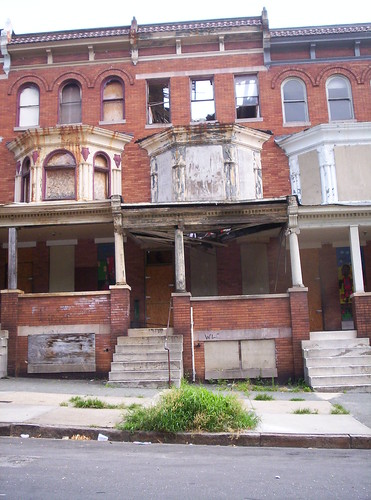
But this street is within a mile or two of Penn Station, Bolton Hill, Hampden, Charles Village, Johns Hopkins...
--------More on this later, as I upload more photos.
Index Keywords: housing; urban-revitalization



0 Comments:
Post a Comment
<< Home